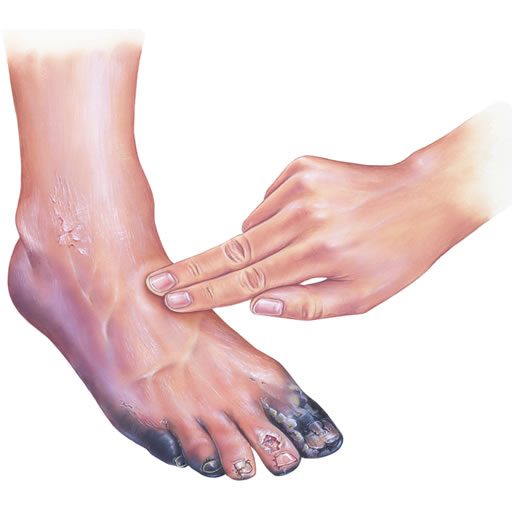If you or someone close to you has diabetes, you probably understand how important foot care is. When gangrene develops, it can feel overwhelming. The word itself sounds serious, and it truly is, but that doesn’t mean you’re out of options.
With proper diabetic foot gangrene care and close attention, treating diabetes does not always require surgery. In many cases, non-surgical methods can support healing and recovery.
Together, let’s go over these choices one by one.

What is Diabetic Foot Gangrene?
First of all, could we define what we’re dealing with here? Gangrene happens when tissue in the body dies because it doesn’t get enough blood flow. An infection can make this worse. People who have diabetes often have problems with their feet.
If you have noticed blackening or greenish discolouration of your skin, a foul smell, or numbness in your feet, it is time to take serious notice. Diabetic foot gangrene care is crucial to prevent life-threatening complications.
These symptoms may indicate the need to seek immediate treatment for diabetic foot gangrene from a medical practitioner. But keep hope alive. Early diagnosis of the ailment has led to an increase in the use of nonsurgical methods.
Can Gangrene Be Treated Without Surgery?
It can, actually! You do not always need surgery or tissue removal. If the infection isn’t too deep or widespread, gangrene is treatable without surgery nowadays.
Restoring circulation, controlling the infection, and letting the body heal itself are the goals of nonsurgical treatment. The risk of amputation can be considerably decreased with prompt diabetic foot gangrene care.
Top Non-Surgical Ways to Tackle Gangrene (No Scalpel Needed!)
Hyperbaric Oxygen Therapy
Let’s start with something quite intriguing: hyperbaric oxygen therapy (HBOT). You can inhale pure oxygen while lying in a chamber. It sounds relaxing, doesn’t it? But it’s also therapeutic.
HBOT increases the oxygen in your blood, which promotes faster healing in infected tissues. It is a painless, safe method to improve diabetic foot gangrene care treatment, particularly with antibiotics.
Doctors can prescribe more than one session, and the results can be amazing, with less infection, better blood flow, and, in some cases, the wound closing completely.
Advanced Wound Care
Significant changes have occurred in the realm of wound care. We now have medicated dressings, growth factor gels, and even skin substitutes that can help repair damaged tissues.
This kind of care is very important for diabetic foot gangrene, especially if the wound is still open. Nurses and podiatrists clean the wound, remove dead tissue (debridement), and put on special dressings that speed up the healing process.
What’s even more remarkable is that the entire process is non-invasive. So, yes, gangrene treatment without surgery is already a reality in clinics around the globe.
Antibiotics
Feverish infections are stealthy, especially when they begin in diabetic feet. That’s why antibiotics are so necessary. Given orally or via intravenous tubing, they keep unwanted bacteria from multiplying before the infection spreads.
In more severe cases, antibiotics alone are clearly not sufficient. But when combined with oxygen therapy and wound care, they are vital in the management of diabetic foot gangrene. Additionally, initiating treatment early increases the likelihood of saving the injured foot.
Natural Solutions
Aloe vera, turmeric, garlic, and honey are worth discussing. They are all popular natural remedies, and there is good reason why. They combat inflammation and bacteria, which can promote recovery.
They are not a replacement for medical treatment, but you can use them in conjunction with your doctor’s routine.
Blood Sugar Control
One of the most critical aspects of diabetic foot gangrene care is blood sugar control. A beneficial rule of thumb: improved blood sugar control is associated with enhanced healing. Ineffective blood sugar management raises the risk of infection and impedes healing.
Thus, tight blood sugar control is essential to treating gangrene of the foot in a person with diabetes. This includes being mindful of what you eat, taking your prescription drugs as directed, and routinely checking your blood sugar levels.
Avoiding Problems in the Future
Like avoiding future problems, healing is really vital. A few of the most significant things you should know are:
- Every day, look for cuts, blisters, or changes in the colour of your feet.
- Keep your feet dry and clean.
- Wear well-fitting shoes that are not painful to wear.
- Wear shoes whenever you are walking.
- Ask your physician to examine your feet frequently.
The key is to stay vigilant and never ignore the small signals. By acting early, you can prevent many future complications. Also, you can avoid the necessity of any gangrene treatment without surgery altogether.
Final Thoughts
Diabetic foot gangrene is severe, but it doesn’t always lead to drastic outcomes. Because of advances in medicine, many treatments can now be done without surgery.
The choices include hyperbaric oxygen therapy, wound care, and antibiotics. Also, preventive diabetic foot gangrene care includes regular doctor visits and foot exams.
Are you feeling pain or seeing changes after surgery or an injury? It might be bad. The early years are crucial for care.
Call us today to make an appointment for expert, non-surgical gangrene treatment. Call Dr. Gaurav at +91 9082 3947 87 for quick help.



